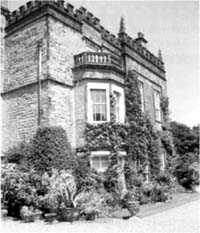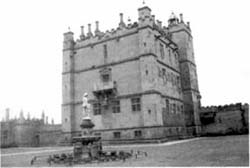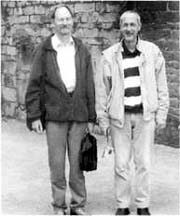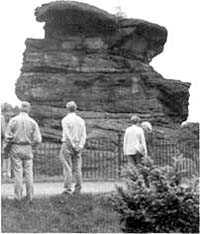Society events and lectures, Summer 2003
Saturday 14 June: Renishaw Hall. Leader: Peter Reddish
 |
Renishaw Hall, south aspect. |
What on earth has an American Red Oak to do with Edwinstowe? The church
leaflet will mention the grave of E Cobham Brewer - he of the Dictionary
of Phrase and Fable fame - as being 'near' the Tower. A more precise indicator
is the Red Oak, a large tree with low-growing boughs sheltering a small
sturdy stone cross on a stepped pedestal. Inside St. Michael's church is
a stitched map of the parish, a work of art in the tradition of the embroidered
Road map in Nottingham Costume Museum. Renishaw - I'm a Sitwell fan and
Renishaw is about the Sitwells. They left their mark on the architecture
and the collections. But Edith and Osbert were not only patrons of the
Arts, they were also professional artists themselves. Edith's ear for spoken
sound values is as elegant as work by Adam or Mozart. The abstract poems
of Facade by Edith were set to music by a 19-year old student, the young
Sir William Walton, perfectly matching her moods and rhythms. The exhibition
of Sitwell memorabilia included editions of Facade. The works of their
friend, artist John Piper, are also on display. My thanks, on behalf of
others, for our welcome at St. Michael's and Peter and Anne Reddish's planning
of such a pleasant day.
Keith Goodman
The excursion proved very popular and many people were disappointed not to be able to attend the excursion. If there is sufficient interest it is hoped to arrange a second visit. This would not be an official excursion, and members would be expected to make their own way there; the Society would merely facilitate the formation of a group (minimum 20). If you are interested contact Keith Goodman, 59 Briar Gate, Long Eaton, Nottingham, NGIO 4BQ.
Thursday 3 July: Bolsover and Sutton Scarsdale Leaders: Philip Jones and Trevor Foulds
 |
The Keep or Little Castle, Bolsover. |
After a wet and slightly late start, the picturesque route was taken to Bolsover via Cuckney and Nether Langworth. Philip Jones explained that the group was booked in as mature students on an educational visit! Trevor Foulds gave an explanation of the history of the castle, saying that much of what appears in the guide book may be incorrect - for eample, there is no evidence that horses lived in the stables of the riding house. Robert Smithson is credited with designing the present castle which the Cavendish family inhabited; the earlier building was occupied by the Earl of Shrewsbury. Before leaving there was time to look around the town of Bolsover, but there were no sightings of the 'beast'!
 |
Excursion leaders, Philip Jones and Trevor Foulds. |
Our second stop of the day took us to Sutton Scarsdale Hall which was
visible across the valley from the castle. The hall, which is now a ruin,
was built in the early eighteenth century around the nucleus of an earlier
hall. In 1824 it was bought by Richard Arkwright, the son of the inventor
and industrialist, and it remained in the family until 1920. There was
much interest and discussion about the layout, particularly regarding the
main entrance and the much more photographed East Side. Tea and biscuits
were taken in the adjoining St Mary's church.
Peter Reddish
Thursday 10 July: Hemlock Stone and Bramcote Walled Garden, including
the Ice House
Leaders: John Beckett, Barbara Brooke and Alan Clayton
 |
The Hemlock Stone, with assembled Thoroton Society members. |
Around fifty Thoroton Society members gathered for an evening visit to the Bramote-Stapleford area. Barbara Brooke talked about the Bramcote walled garden and ice house, and we then crossed the road (and the parish boundary) into Stapleford, where Alan Clayton told us a little about the Hemlockstone, the sandstone tower just at the side of Coventry Lane (pictured left).
We then moved on to the church hall at Bramcote, where members of the Bramcote Local History Society served tea and biscuits, and showed us around the church: built 1861, Gothic revival, replacing an earlier building of which only the tower remains) and their collection of historic photographs.
This was a joint event with the Stapleford and Bramcote local history
societies, and we are grateful to both, and particularly to Barbara Brooke
and Val Bird, for their help with setting it up.
John Beckett